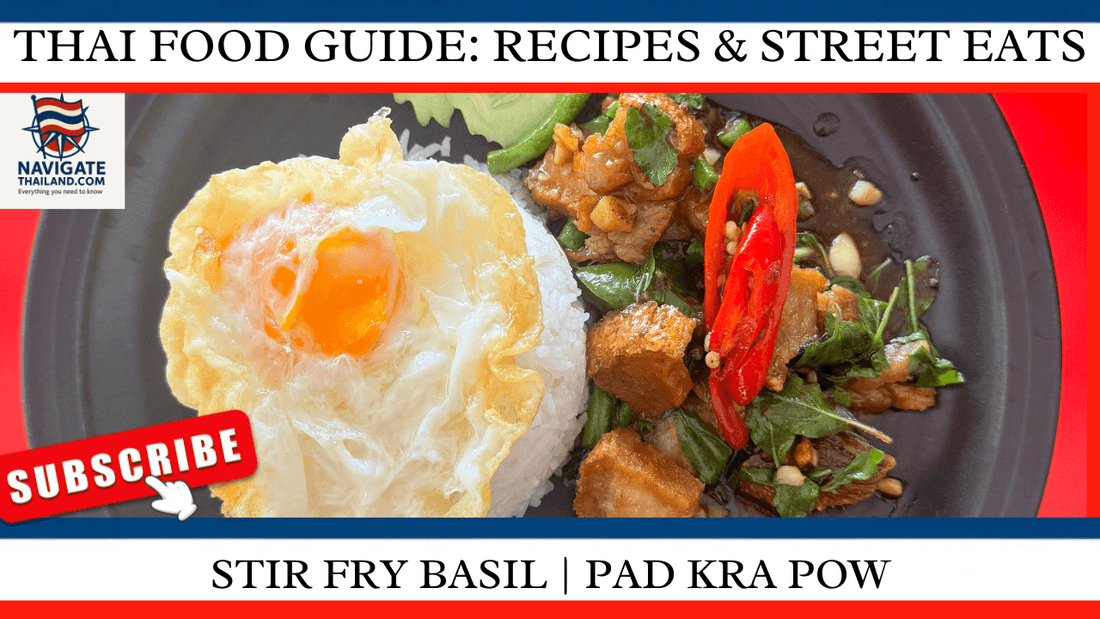
Pad Kra Pow: Thailand’s Stir-Fried Basil Dish You Need to Try
Share
Thailand is home to many culinary treasures, and one of the most beloved dishes among locals and travellers alike is Pad Kra Pow—stir-fried basil with minced meat. Known for its rich flavours, aromatic basil, and perfect balance of salty, spicy, and savoury tastes, Pad Kra Pow has become a staple dish served in countless street food stalls, homes, and restaurants across the country. For those seeking an authentic taste of Thailand, Pad Kra Pow is a must-try.
In this blog, we will explore everything you need to know about Pad Kra Pow, from its origins to its unique ingredients, nutritional benefits, and how you can easily recreate this dish at home. Whether you’re travelling through Thailand or looking to bring the flavours of Thai street food into your kitchen, this guide will equip you with all the essentials.
What Is Pad Kra Pow?
Pad Kra Pow is a classic Thai stir-fry dish that typically consists of minced pork, chicken, or beef, stir-fried with garlic, chillies, and the key ingredient—holy basil (Kra Pow). It’s a dish that is famous for its bold flavours, thanks to the combination of spicy chillies, fragrant garlic, and the distinctive peppery taste of holy basil. The stir-fry is usually served over steamed jasmine rice and topped with a crispy fried egg, creating a delicious and satisfying meal.
The dish can be adjusted according to taste preferences, with some variations adding vegetables, tofu, or seafood. Despite its versatility, the signature taste of Pad Kra Pow comes from the use of fresh holy basil, which has a unique flavour compared to the more commonly used sweet basil.
Fun Fact: Holy basil, known as Kra Pow in Thai, is different from Thai sweet basil. It has a peppery, slightly spicy taste that gives Pad Kra Pow its distinctive kick.
Origins of Pad Kra Pow
Pad Kra Pow is deeply rooted in Thai street food culture. Its origins date back to when street vendors began selling quick and affordable meals to cater to busy workers and travellers. The dish’s simplicity and ability to be cooked quickly over high heat made it ideal for the bustling streets of Bangkok and other major Thai cities.
Today, Pad Kra Pow is one of the most popular street food dishes in Thailand, enjoyed by people of all walks of life. From small food carts to high-end restaurants, Pad Kra Pow is a dish that represents the heart and soul of Thai street food—bold, flavourful, and satisfying.
Nutritional Benefits of Pad Kra Pow
Pad Kra Pow, while rich in flavour, can also be a nutritious meal, especially when made with fresh, high-quality ingredients. Here’s a breakdown of the nutritional value you can expect from a typical serving of Pad Kra Pow (without rice or egg):
• Calories: Approximately 250-350 calories per serving, depending on the protein used.
• Protein: 20-25 grams, making it a good source of protein when prepared with pork, chicken, or tofu.
• Carbohydrates: Minimal carbs unless served with rice.
• Fat: 10-15 grams, mostly coming from the oil used for stir-frying and the natural fat in the meat or tofu.
• Vitamins and minerals: The dish is a good source of vitamin A and vitamin C, thanks to the garlic, chillies, and basil, and it also provides important minerals like iron and calcium.
Holy basil, the star of the dish, is known for its anti-inflammatory and antioxidant properties, adding a healthy dimension to this spicy stir-fry.
Fun Fact: Holy basil is often used in traditional Thai medicine to help with digestive issues, stress relief, and to boost immunity.
How to Make Pad Kra Pow at Home
If you’re craving the authentic flavours of Thailand, you’ll be happy to know that Pad Kra Pow is relatively easy to make at home. With a few simple ingredients and a good wok or frying pan, you can whip up this dish in just 20 minutes.
Ingredients (serves 2):
• 200 grams minced pork (or chicken, beef, or tofu for a vegetarian version)
• 2 tablespoons vegetable oil
• 3-4 cloves garlic, minced
• 3-5 bird’s eye chillies (adjust according to spice tolerance), chopped
• 1 tablespoon soy sauce
• 1 tablespoon fish sauce (use soy sauce for vegetarian)
• 1 teaspoon oyster sauce (optional for added flavour)
• 1 teaspoon sugar
• 1 handful of holy basil leaves (approximately 20-30 leaves)
• 2 eggs (for topping)
• Steamed jasmine rice (for serving)
Instructions:
1. Prepare the Ingredients: Start by chopping the garlic and bird’s eye chillies. Set them aside, along with the holy basil leaves. If using tofu, press it for 10-15 minutes before cubing it for stir-frying.
2. Fry the Egg: Heat a tablespoon of oil in a separate pan and fry the eggs until the edges are crispy. Remove and set aside.
3. Stir-Fry the Meat: In a hot wok or frying pan, add the remaining oil. Once heated, add the minced garlic and chillies, stirring for about 30 seconds until fragrant. Be careful not to burn the garlic.
4. Add the Protein: Add the minced pork (or chosen protein) to the pan and stir-fry over medium-high heat. Break up the meat and cook until fully browned.
5. Season the Dish: Add the soy sauce, fish sauce, oyster sauce (optional), and sugar to the meat mixture. Stir well and allow the sauces to coat the meat evenly.
6. Add the Holy Basil: Once the meat is cooked and the sauce has thickened, toss in the holy basil leaves. Stir quickly and cook for another 30 seconds until the basil is wilted and fragrant.
7. Serve: Serve the stir-fried meat and basil over a bed of steamed jasmine rice, and top it with a crispy fried egg.
Fun Fact: In Thailand, the egg served with Pad Kra Pow is often cooked with crispy edges and a runny yolk, adding richness to the dish when mixed with the rice and stir-fry.
Variations of Pad Kra Pow
While the traditional version of Pad Kra Pow uses minced pork or chicken, there are several variations of this dish that cater to different tastes and dietary preferences:
1. Pad Kra Pow Gai: Made with minced chicken, this version is lighter than the pork variant and is equally popular across Thailand.
2. Vegetarian Pad Kra Pow: Made with tofu or tempeh and soy sauce instead of fish sauce, this is a great option for vegetarians or those looking for a plant-based meal.
3. Pad Kra Pow Moo Krob: A decadent version of the dish made with crispy pork belly, adding an extra layer of texture and flavour.
4. Pad Kra Pow Seafood: A coastal twist on the traditional recipe, this version includes shrimp, squid, or a mix of seafood.
Why Travellers Love Pad Kra Pow
For travellers, Pad Kra Pow is often one of the first dishes they encounter in Thailand’s vibrant street food scene. Its bold flavours, quick preparation, and ability to be customised make it a crowd-pleaser among tourists and locals alike. Whether you’re exploring the night markets of Bangkok or relaxing on a beach in Phuket, you’re likely to find this dish on almost every menu.
Fun Fact: Pad Kra Pow is considered a “one-dish meal” in Thailand, meaning it’s often ordered as a standalone dish, perfect for a quick and satisfying lunch or dinner.
Conclusion
Pad Kra Pow is a quintessential Thai dish that offers a perfect balance of flavour and simplicity. Its use of fresh ingredients, especially holy basil, combined with savoury sauces and proteins, makes it a must-try for anyone looking to experience authentic Thai cuisine. Whether you’re exploring Thailand’s street food stalls or recreating this dish at home, Pad Kra Pow is sure to delight your taste buds.
Have you tried Pad Kra Pow on your travels or made it at home? Share your experience in the comments below, and don’t forget to share this blog on your social media! For more authentic Thai recipes and travel tips, subscribe to our YouTube channel, where we’ll be bringing this blog to life in video form.
References:
• Lonely Planet: “A Guide to Thailand’s Best Street Foods”
• National Geographic: “The Global Appeal of Thai Basil”
• Thai Culinary Institute: “Traditional Stir-Fry Dishes in Thai Cooking”
Read more of our Thailand blog series:
Thai Food Guide:Traditional Recipes and Street Eats
Everything Travellers Need to know
Thailand travel ebooks and language guides
Thailand Travel Apparel & Souvenir Gifts
Subscribe to our YouTube channel Navigate Thailand to see our most popular Thailand travel blogs turned into videos:
Navigate Thailand YouTube channel
















































































































































